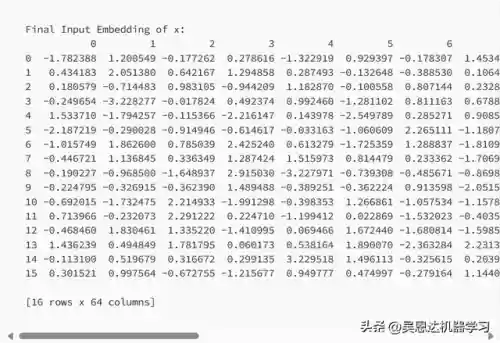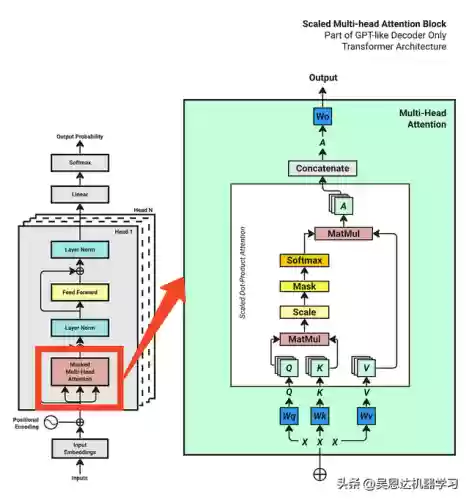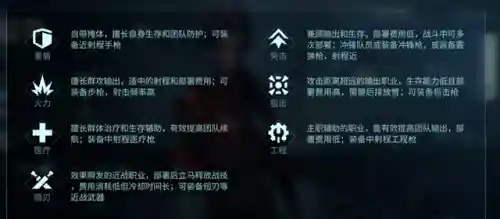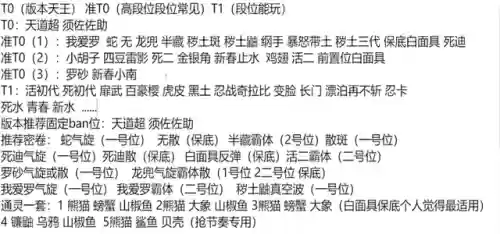实况2224阵容(实况2024最强阵容)
#头条首发大赛#

在本文中,我们将从头开始实现一个类似 GPT 的转换器。我们将按照《Transformer 架构 (LLM: Zero-to-Hero)》文章中描述的步骤对每个部分进行编码。
本文中的完整代码已整理好
准备环境
安装依赖项
pip install numpy requests torch tiktoken matplotlib pandas
import osimport requestsimport pandas as pdimport matplotlib.pyplot as pltimport mathimport tiktokenimport torchimport torch.nn as nn
设置超参数
超参数是模型的外部配置,在训练期间无法从数据中学习。它们是在训练过程开始之前设置的,在控制训练算法的行为和训练模型的性能方面起着至关重要的作用。
# Hyperparametersbatch_size = 4 # How many batches per training stepcontext_length = 16 # Length of the token chunk each batchd_model = 64 # The vector size of the token embeddingsnum_layers = 8 # Number of transformer blocksnum_heads = 4 # Number of heads in Multi-head attention learning_rate = 1e-3 # 0.001dropout = 0.1 # Dropout ratemax_iters = 5000 # Total of training iterationseval_interval = 50 # How often to evaluate the modeleval_iters = 20 # How many iterations to average the loss over when evaluating the modeldevice = 'cuda' if torch.cuda.is_available() else 'cpu' # Instead of using the cpu, we'll use the GPU if it's available.TORCH_SEED = 1337torch.manual_seed(TORCH_SEED)
准备数据集
在我们的示例中,我们将使用一个小型数据集进行训练。数据集是包含销售教科书的文本文件。我们将使用文本文件来训练可以生成销售文本的语言模型。
# download a sample txt file from https://huggingface.co/datasets/goendalf666/sales-textbook_for_convincing_and_selling/raw/main/sales_textbook.txtif not os.path.exists('sales_textbook.txt'): url = 'https://huggingface.co/datasets/goendalf666/sales-textbook_for_convincing_and_selling/raw/main/sales_textbook.txt' with open('sales_textbook.txt', 'w') as f: f.write(requests.get(url).text)with open('sales_textbook.txt', 'r', encoding='utf-8') as f: text = f.read()
第 1 步:标记化
我们将使用 tiktoken 库对数据集进行标记化。该库是一个快速且轻量级的标记器,可用于将文本标记为标记。
# Using TikToken to tokenize the source textencoding = tiktoken.get_encoding("cl100k_base")tokenized_text = encoding.encode(text) # size of tokenized source text is 77,919vocab_size = len(set(tokenized_text)) # size of vocabulary is 3,771max_token_value = max(tokenized_text)print(f"Tokenized text size: {len(tokenized_text)}")print(f"Vocabulary size: {vocab_size}")print(f"The maximum value in the tokenized text is: {max_token_value}")
打印输出:
Tokenized text size: 77919Vocabulary size: 3771The maximum value in the tokenized text is: 100069
第 2 步:单词嵌入
我们将数据集拆分为训练集和验证集。训练集将用于训练模型,验证集将用于评估模型的性能。
# Split train and validationsplit_idx = int(len(tokenized_text) * 0.8)train_data = tokenized_text[:split_idx]val_data = tokenized_text[split_idx:]# Prepare data for training batch# Prepare data for training batchdata = train_dataidxs = torch.randint(low=0, high=len(data) - context_length, size=(batch_size,))x_batch = torch.stack([data[idx:idx + context_length] for idx in idxs])y_batch = torch.stack([data[idx + 1:idx + context_length + 1] for idx in idxs])print(x_batch.shape, x_batch.shape)
打印输出(训练输入 x 和 y 的形状):
torch.Size([4, 16]) torch.Size([4, 16])
第 3 步:位置编码
我们将使用一个简单的嵌入层将输入标记转换为向量。
# Define Token Embedding look-up tabletoken_embedding_lookup_table = nn.Embedding(max_token_value, d_model)# Get X and Y embeddingx = token_embedding_lookup_table(x_batch.data)y = token_embedding_lookup_table(y_batch.data)
现在,我们的输入 x 和 y 都是形状 (batch_size、context_length、d_model)。
# Get x and y embeddingx = token_embedding_lookup_table(x_batch.data) # [4, 16, 64] [batch_size, context_length, d_model]y = token_embedding_lookup_table(y_batch.data)
应用位置嵌入
正如原来的“Attention is All You Need”一文中所描述的,我们将使用正弦和余弦来生成一个位置嵌入表,然后将这些位置信息添加到输入嵌入标记中。
# Define Position Encoding look-up tableposition_encoding_lookup_table = torch.zeros(context_length, d_model) # initial with zeros with shape (context_length, d_model)position = torch.arange(0, context_length, dtype=torch.float).unsqueeze(1)# apply the sine & cosinediv_term = torch.exp(torch.arange(0, d_model, 2).float() * (-math.log(10000.0) / d_model))position_encoding_lookup_table[:, 0::2] = torch.sin(position * div_term)position_encoding_lookup_table[:, 1::2] = torch.cos(position * div_term)position_encoding_lookup_table = position_encoding_lookup_table.unsqueeze(0).expand(batch_size, -1, -1) #add batch to the first dimensionprint("Position Encoding Look-up Table: ", position_encoding_lookup_table.shape)
打印输出:
Position Encoding Look-up Table: torch.Size([4, 16, 64])
然后,将位置编码添加到输入嵌入向量中。
# Add positional encoding into the input embedding vectorinput_embedding_x = x + position_encoding_lookup_table # [4, 16, 64] [batch_size, context_length, d_model]input_embedding_y = y + position_encoding_lookup_tableX = input_embedding_xx_plot = input_embedding_x[0].detach().cpu().numpy()print("Final Input Embedding of x: \n", pd.DataFrame(x_plot))
现在,我们得到 X 的最终输入嵌入,这是要馈送到变压器模块中的值:
Final Input Embedding of x: 0 1 2 3 4 5 6 7 8 9 ... 54 55 56 57 58 59 60 61 62 630 -1.782388 1.200549 -0.177262 0.278616 -1.322919 0.929397 -0.178307 1.453488 -0.216367 -2.049190 ... -0.009743 2.694576 -0.592321 1.235002 1.137691 1.076938 -1.583359 1.994682 -0.411284 2.3655981 0.434183 2.051380 0.642167 1.294858 0.287493 -0.132648 -0.388530 0.106470 0.515283 1.686583 ... 0.423079 0.564006 -1.514647 0.263115 -2.233931 1.759137 2.413690 -0.372896 0.512504 2.8312462 0.180579 -0.714483 0.983105 -0.944209 1.182870 -0.100558 0.807144 0.232830 -0.455422 2.246022 ... 0.056277 0.913973 -0.200273 0.688581 1.302482 2.202587 -0.980815 -0.181238 0.747766 1.7429573 -0.249654 -3.228277 -0.017824 0.492374 0.992460 -1.281102 0.811163 0.678884 0.251492 0.319295 ... 1.329760 1.259970 -0.345209 1.030813 0.629613 1.289158 0.586766 0.970829 1.487210 0.8589704 1.533710 -1.794257 -0.115366 -2.216147 0.143978 -2.549789 0.285271 0.908505 -1.371307 1.000596 ... -0.171948 1.476006 -0.411271 2.187133 0.580001 1.330921 -0.996333 3.353865 0.216231 -0.5705385 -2.187219 -0.290028 -0.914946 -0.614617 -0.033163 -1.060609 2.265111 -1.180711 1.237476 0.817889 ... 1.869089 0.720627 -1.679796 1.405375 0.399367 0.725817 -0.047124 -0.977291 0.013971 0.8195226 -1.015749 1.862600 0.785039 2.425240 0.613279 -1.725359 1.288837 -1.810941 2.514978 0.433844 ... 0.408046 1.537934 -0.192739 0.709489 0.535088 -0.347714 -2.239857 -0.033674 0.192698 -0.1365567 -0.446721 1.136845 0.336349 1.287424 1.515973 0.814479 0.233362 -1.706994 -0.438097 -0.674278 ... 0.697751 0.913269 -0.332155 -0.149376 0.140298 2.597988 0.219866 1.489297 1.089043 -1.2654918 -0.190227 -0.968500 -1.648937 2.915030 -3.227971 -0.739308 -0.485671 -0.869817 -0.153695 -1.206717 ... 1.403767 0.636459 0.094945 -0.747135 0.495720 0.164661 -0.610816 0.730676 0.587971 2.3416179 -0.224795 -0.326915 -0.362390 1.489488 -0.389251 -0.362224 0.913598 -2.051510 0.778566 -0.696349 ... 0.394737 1.314234 -0.124517 1.888481 0.689187 0.396996 1.056659 0.785319 1.079981 -0.19457510 -0.692015 -1.732475 2.214933 -1.991298 -0.398353 1.266861 -1.057534 -1.157881 -0.801310 -0.614316 ... -1.901223 -0.854748 0.163998 0.173750 -1.058628 1.532371 -0.257311 1.359694 1.033851 0.67712311 0.713966 -0.232073 2.291222 0.224710 -1.199412 0.022869 -1.532023 -0.403545 -0.262371 -1.097961 ... 1.827974 0.126189 1.134699 0.425639 -1.347956 0.086310 -0.774953 1.218501 -1.761807 0.11746412 -0.468460 1.830461 1.335220 -1.410995 0.069466 1.672440 -1.680814 -1.598549 0.521277 -1.871883 ... -1.775825 -0.046493 0.723062 1.785805 1.166462 2.608919 1.078712 2.193650 1.377550 1.00275313 1.436239 0.494849 1.781795 0.060173 0.538164 1.890070 -2.363284 2.231389 -1.082167 0.040986 ... -0.764243 -1.155260 0.084449 1.592648 0.105955 1.080390 -1.063937 0.691866 -0.906071 0.38377914 -0.113100 0.519679 0.316672 0.299135 3.229518 1.496113 -0.325615 0.203938 -2.198124 -0.356190 ... 0.700703 0.913256 -0.329941 -0.149384 0.141958 2.597984 0.221110 1.489295 1.089976 -1.26549315 0.301521 0.997564 -0.672755 -1.215677 0.949777 0.474997 -0.279164 1.144048 -1.059472 0.068650 ... 0.796498 -1.032138 0.977697 0.790623 0.725540 1.646803 1.253047 0.296801 0.798098 2.022164[16 rows x 64 columns]

注意:y 嵌入向量的形状将与我们的 x 相同。
第 4 步:变压器块4.1 多头注意力概述
让我们带回我们的多头注意力图。

现在我们有了嵌入 X 的输入,我们可以开始实现 Multi-head Attention 模块了。将有一系列步骤来实现多头注意力块。让我们一一编码。
4.2 准备Q,K,V
# Prepare Query, Key, Value for Multi-head Attentionquery = key = value = X # [4, 16, 64] [batch_size, context_length, d_model]# Define Query, Key, Value weight matricesWq = nn.Linear(d_model, d_model)Wk = nn.Linear(d_model, d_model)Wv = nn.Linear(d_model, d_model)Q = Wq(query) #[4, 16, 64]Q = Q.view(batch_size, -1, num_heads, d_model // num_heads) #[4, 16, 4, 16]K = Wk(key) #[4, 16, 64]K = K.view(batch_size, -1, num_heads, d_model // num_heads) #[4, 16, 4, 16]V = Wv(value) #[4, 16, 64]V = V.view(batch_size, -1, num_heads, d_model // num_heads) #[4, 16, 4, 16]
然后,我们将 Q、K、V 重塑为 [batch_size、num_heads、context_length、head_size] 以进行进一步计算。
# Transpose q,k,v from [batch_size, context_length, num_heads, head_size] to [batch_size, num_heads, context_length, head_size]# The reason is that treat each batch with "num_heads" as its first dimension.Q = Q.transpose(1, 2) # [4, 4, 16, 16]K = K.transpose(1, 2) # [4, 4, 16, 16]V = V.transpose(1, 2) # [4, 4, 16, 16]
4.3 计算QK^T注意力
这可以通过使用 torch.matmul 函数非常容易地完成。
# Calculate the attention score betwee Q and K^Tattention_score = torch.matmul(Q, K.transpose(-2, -1))
4.4 规模
# Then Scale the attention score by the square root of the head sizeattention_score = attention_score / math.sqrt(d_model // num_heads)
我们实际上可以在一行中重写 4.3 和 4.4:
attention_score = torch.matmul(Q, K.transpose(-2, -1)) / math.sqrt(d_model // num_heads) # [4, 4, 16, 16] #[4, 4, 16, 16] [batch_size, num_heads, context_length, context_length]print(pd.DataFrame(attention_score[0][0].detach().cpu().numpy()))
打印输出(一批一个序列):
0 1 2 3 4 5 6 7 8 9 10 11 12 13 14 150 0.105279 -0.365092 -0.339839 -0.650558 -0.464043 -0.531401 0.437939 -0.650732 -0.616331 -0.429000 -0.332607 0.080401 0.000111 -0.601670 -0.783942 0.1479671 -0.302636 0.525435 0.863502 -0.218539 0.600691 -0.413970 0.408111 0.765074 -0.376257 0.233526 0.915393 -0.263153 0.683832 0.430964 0.802033 0.2811692 0.201820 0.156336 -0.245585 0.101653 0.228243 -0.565197 0.589193 -0.579525 -0.080071 0.078848 -0.471447 0.481268 -0.129725 -0.123364 -0.963065 -0.5821263 0.517998 -0.303064 0.484515 -0.399551 -0.004528 -0.028223 -0.602194 0.107085 -0.504462 0.017590 0.592893 -0.750240 0.022489 -0.014217 -0.038678 0.4846334 0.519200 0.322036 0.328027 -0.031755 0.006269 0.133609 -0.095071 -0.252013 0.096449 -0.268063 -0.306129 -0.045432 -0.027766 -0.163095 -0.338737 0.7129015 -0.635913 0.137114 0.083046 0.234778 -0.668992 -0.366838 -0.613126 0.245075 -0.042131 0.221872 0.806992 -0.279996 0.046113 0.646270 0.284564 0.4782986 -0.287777 -0.841604 -0.128455 -0.566180 0.079559 -0.530863 -0.082675 0.072495 -0.264806 -0.229649 0.269325 -0.185602 -0.366693 -0.321176 -0.130587 0.4161217 -0.798519 -0.905525 0.317880 -0.176577 0.751465 -0.564863 1.014724 -0.068284 -0.527703 0.118972 0.085287 -0.102589 -0.640548 0.376717 -0.120097 0.1640748 0.141614 -0.022169 0.152088 -0.519404 -0.069152 -0.880496 -0.229767 -0.849347 -0.539544 -0.510258 -0.246146 -0.266640 -0.086958 -0.577571 -1.191547 0.0503069 -0.097493 0.860376 0.073501 0.150553 -0.651579 -0.376676 -0.691368 0.315606 0.135982 0.292198 0.774460 -0.131879 0.626085 0.452120 0.153703 0.08238610 -0.469827 0.302545 -0.015767 -0.175387 -0.049927 -0.706852 0.511237 0.043908 -0.492887 -0.168435 -0.167744 0.016956 0.141400 -0.102674 -0.072396 -0.26155811 -0.335474 -0.399539 -0.093901 -0.682290 0.312682 -0.310319 0.344753 0.017465 -0.364808 -0.262316 -0.282589 -0.239767 0.008904 -0.621042 -0.261246 -0.21488812 -1.757631 -0.967825 -0.516159 -0.246766 -0.352132 -0.780370 -0.262975 -0.793605 -0.238561 -0.374695 -0.132526 -0.126956 -0.524015 -0.194315 -1.046538 -0.40256013 0.550975 0.313643 -0.074468 0.519995 -0.149188 -0.565922 0.199527 -0.738029 0.142203 -0.164007 -0.494203 0.570010 -0.579608 -0.198923 -0.869503 -0.12021814 -0.616347 -0.812240 0.245260 0.167278 0.913596 -0.493119 1.139083 -0.300623 -0.399155 0.200648 -0.114634 0.147219 -0.829207 0.363519 -0.325846 0.02684015 -0.145391 0.514632 -0.296119 -0.038103 -0.187110 -0.634636 0.509902 -0.338267 -0.231534 -0.007304 -0.432799 0.339123 0.248173 -0.242426 -0.595925 -0.442379
4.5 面具
# Apply Mask to attention scoresattention_score = attention_score.masked_fill(torch.triu(torch.ones(attention_score.shape[-2:]), diagonal=1).bool(), float('-inf')) #[4, 4, 16, 16] [batch_size, num_heads, context_length, context_length]print(pd.DataFrame(attention_score[0][0].detach().cpu().numpy()))
打印输出(一批一个序列):
0 1 2 3 4 5 6 7 8 9 10 11 12 13 14 150 0.105279 -inf -inf -inf -inf -inf -inf -inf -inf -inf -inf -inf -inf -inf -inf -inf1 -0.302636 0.525435 -inf -inf -inf -inf -inf -inf -inf -inf -inf -inf -inf -inf -inf -inf2 0.201820 0.156336 -0.245585 -inf -inf -inf -inf -inf -inf -inf -inf -inf -inf -inf -inf -inf3 0.517998 -0.303064 0.484515 -0.399551 -inf -inf -inf -inf -inf -inf -inf -inf -inf -inf -inf -inf4 0.519200 0.322036 0.328027 -0.031755 0.006269 -inf -inf -inf -inf -inf -inf -inf -inf -inf -inf -inf5 -0.635913 0.137114 0.083046 0.234778 -0.668992 -0.366838 -inf -inf -inf -inf -inf -inf -inf -inf -inf -inf6 -0.287777 -0.841604 -0.128455 -0.566180 0.079559 -0.530863 -0.082675 -inf -inf -inf -inf -inf -inf -inf -inf -inf7 -0.798519 -0.905525 0.317880 -0.176577 0.751465 -0.564863 1.014724 -0.068284 -inf -inf -inf -inf -inf -inf -inf -inf8 0.141614 -0.022169 0.152088 -0.519404 -0.069152 -0.880496 -0.229767 -0.849347 -0.539544 -inf -inf -inf -inf -inf -inf -inf9 -0.097493 0.860376 0.073501 0.150553 -0.651579 -0.376676 -0.691368 0.315606 0.135982 0.292198 -inf -inf -inf -inf -inf -inf10 -0.469827 0.302545 -0.015767 -0.175387 -0.049927 -0.706852 0.511237 0.043908 -0.492887 -0.168435 -0.167744 -inf -inf -inf -inf -inf11 -0.335474 -0.399539 -0.093901 -0.682290 0.312682 -0.310319 0.344753 0.017465 -0.364808 -0.262316 -0.282589 -0.239767 -inf -inf -inf -inf12 -1.757631 -0.967825 -0.516159 -0.246766 -0.352132 -0.780370 -0.262975 -0.793605 -0.238561 -0.374695 -0.132526 -0.126956 -0.524015 -inf -inf -inf13 0.550975 0.313643 -0.074468 0.519995 -0.149188 -0.565922 0.199527 -0.738029 0.142203 -0.164007 -0.494203 0.570010 -0.579608 -0.198923 -inf -inf14 -0.616347 -0.812240 0.245260 0.167278 0.913596 -0.493119 1.139083 -0.300623 -0.399155 0.200648 -0.114634 0.147219 -0.829207 0.363519 -0.325846 -inf15 -0.145391 0.514632 -0.296119 -0.038103 -0.187110 -0.634636 0.509902 -0.338267 -0.231534 -0.007304 -0.432799 0.339123 0.248173 -0.242426 -0.595925 -0.442379
正如我们所看到的,对角线和上三角形被 -inf 遮盖。
4.6 软极
# Softmax the attention scoreattention_score = torch.softmax(attention_score, dim=-1) #[4, 4, 16, 16] [batch_size, num_heads, context_length, context_length]print(pd.DataFrame(attention_score.detach().cpu().numpy()))
打印输出(一批一个序列):
0 1 2 3 4 5 6 7 8 9 10 11 12 13 14 150 0.062604 0.062472 0.062478 0.062419 0.062452 0.062439 0.062748 0.062419 0.062424 0.062459 0.062479 0.062595 0.062568 0.062427 0.062399 0.0626191 0.062377 0.062529 0.062643 0.062387 0.062551 0.062364 0.062499 0.062605 0.062368 0.062460 0.062664 0.062381 0.062577 0.062505 0.062619 0.0624702 0.062565 0.062551 0.062453 0.062535 0.062574 0.062400 0.062717 0.062398 0.062488 0.062529 0.062414 0.062668 0.062477 0.062479 0.062354 0.0623983 0.062647 0.062427 0.062634 0.062411 0.062486 0.062480 0.062384 0.062513 0.062396 0.062491 0.062679 0.062367 0.062492 0.062483 0.062478 0.0626344 0.062635 0.062566 0.062567 0.062473 0.062481 0.062512 0.062460 0.062430 0.062502 0.062428 0.062421 0.062470 0.062474 0.062446 0.062416 0.0627205 0.062371 0.062501 0.062488 0.062527 0.062367 0.062405 0.062373 0.062529 0.062461 0.062523 0.062744 0.062418 0.062480 0.062669 0.062541 0.0626036 0.062467 0.062379 0.062504 0.062417 0.062562 0.062422 0.062516 0.062560 0.062472 0.062480 0.062628 0.062490 0.062451 0.062460 0.062503 0.0626897 0.062358 0.062348 0.062566 0.062444 0.062742 0.062384 0.062900 0.062465 0.062389 0.062509 0.062500 0.062458 0.062375 0.062585 0.062455 0.0625218 0.062632 0.062573 0.062636 0.062449 0.062559 0.062391 0.062513 0.062395 0.062445 0.062450 0.062509 0.062504 0.062553 0.062438 0.062356 0.0625989 0.062434 0.062727 0.062467 0.062484 0.062360 0.062391 0.062356 0.062525 0.062480 0.062519 0.062687 0.062428 0.062625 0.062565 0.062484 0.06246910 0.062419 0.062608 0.062511 0.062473 0.062502 0.062385 0.062693 0.062527 0.062415 0.062475 0.062475 0.062520 0.062555 0.062490 0.062497 0.06245511 0.062463 0.062450 0.062519 0.062403 0.062655 0.062468 0.062669 0.062551 0.062457 0.062478 0.062474 0.062484 0.062548 0.062412 0.062479 0.06248912 0.062327 0.062405 0.062489 0.062561 0.062530 0.062435 0.062556 0.062433 0.062564 0.062524 0.062599 0.062601 0.062487 0.062578 0.062394 0.06251713 0.062685 0.062591 0.062482 0.062671 0.062466 0.062395 0.062554 0.062374 0.062538 0.062463 0.062405 0.062693 0.062393 0.062456 0.062360 0.06247214 0.062372 0.062352 0.062530 0.062509 0.062806 0.062387 0.062958 0.062414 0.062400 0.062518 0.062447 0.062504 0.062350 0.062566 0.062410 0.06247615 0.062479 0.062693 0.062448 0.062504 0.062470 0.062394 0.062691 0.062440 0.062460 0.062512 0.062424 0.062620 0.062588 0.062458 0.062399 0.062422
应用 softmax 函数后,分数现在介于 0 和 1 之间,每行的总和为 1。
4.7 计算 V 注意力
最后,我们将注意力分数与 V 相乘,得到 Multi-head Attention 模块的输出。
# Calculate the V attention outputA = torch.matmul(attention_score, V) # [4, 4, 16, 16] [batch_size, num_heads, context_length, head_size]print(attention_output.shape)
打印输出:
torch.Size([4, 4, 16, 16])
注意:现在的形状是 [4, 4, 16, 16],即 [batch_size, num_heads, context_length, head_size]。
4.8 连接和输出
回想一下上一篇文章,我们需要将 Multi-head Attention 模块的输出连接起来,并将其馈送到线性层中。
A = A.transpose(1, 2) # [4, 16, 4, 16] [batch_size, context_length, num_heads, head_size]A = A.reshape(batch_size, -1, d_model) # [4, 16, 64] [batch_size, context_length, d_model]
注意:现在的形状是 [4, 16, 64],即 [batch_size, context_length, d_model]。
现在,我们可以应用另一个 [64,64] 线性 Wo 层(这是在训练期间学习的权重),并得到 Multi-head Attention 模块的最终输出:
# Define the output weight matrixWo = nn.Linear(d_model, d_model)output = Wo(A) # [4, 16, 64] [batch_size, context_length, d_model]print(output.shape)
如果我们将其打印出来,形状将返回 [4, 16, 64],这与我们的输入嵌入形状相同。
第 5 步:残差连接和层归一化
现在我们有了 Multi-head Attention 模块的输出,我们可以应用残差连接和层归一化。
# Add residual connectionoutput = output + X# Add Layer Normalizationlayer_norm = nn.LayerNorm(d_model)output = layer_norm(output)
第 6 步:前馈网络
# Define Feed Forward Networkoutput = nn.Linear(d_model, d_model * 4)(output)output = nn.ReLU()(output)output = nn.Linear(d_model * 4, d_model)(output)output = torch.dropout(output, p=dropout, train=True)
添加最后的残差连接和层归一化:
# Add residual connectionoutput = output + X# Add Layer Normalizationlayer_norm = nn.LayerNorm(d_model)output = layer_norm(output)
第 7 步:重复第 4 步至第 6 步
我们上面完成的只是一个变压器块。在实践中,我们将多个变压器模块堆叠在一起,形成一个变压器解码器。
我们实际上应该将代码打包到类中使用 PyTorch nn。模块来构建我们的变压器解码器。但为了演示,我们只留下一个块。
第 8 步:输出概率
应用最后的线性层来获取我们的 logits:
logits = nn.Linear(d_model, max_token_value)(output)print(pd.DataFrame(logits[0].detach().cpu().numpy()))
最后一步是 softmax logits 以获取每个令牌的概率:
# torch.softmax usually used during inference, during training we use torch.nn.CrossEntropyLoss# but for illustration purpose, we'll use torch.softmax hereprobabilities = torch.softmax(logits, dim=-1)
0 1 2 3 4 5 6 7 8 9 ... 100059 100060 100061 100062 100063 100064 100065 100066 100067 1000680 0.000007 0.000008 0.000006 0.000005 0.000004 0.000004 0.000009 0.000007 0.000009 0.000008 ... 0.000013 0.000005 0.000006 0.000014 0.000009 0.000005 0.000005 0.000016 0.000006 0.0000051 0.000018 0.000016 0.000006 0.000017 0.000005 0.000006 0.000005 0.000005 0.000008 0.000004 ... 0.000006 0.000004 0.000006 0.000007 0.000006 0.000007 0.000014 0.000020 0.000004 0.0000012 0.000013 0.000007 0.000008 0.000003 0.000007 0.000009 0.000021 0.000005 0.000007 0.000013 ... 0.000018 0.000009 0.000010 0.000010 0.000018 0.000009 0.000007 0.000008 0.000005 0.0000153 0.000005 0.000013 0.000011 0.000004 0.000006 0.000007 0.000012 0.000006 0.000015 0.000010 ... 0.000032 0.000006 0.000008 0.000005 0.000014 0.000009 0.000021 0.000014 0.000004 0.0000054 0.000005 0.000010 0.000008 0.000006 0.000017 0.000005 0.000010 0.000003 0.000008 0.000010 ... 0.000012 0.000005 0.000010 0.000003 0.000015 0.000022 0.000015 0.000010 0.000013 0.0000055 0.000008 0.000004 0.000007 0.000003 0.000004 0.000011 0.000018 0.000007 0.000002 0.000010 ... 0.000013 0.000004 0.000012 0.000010 0.000015 0.000017 0.000010 0.000019 0.000013 0.0000126 0.000005 0.000008 0.000014 0.000004 0.000007 0.000007 0.000012 0.000016 0.000005 0.000005 ... 0.000012 0.000007 0.000012 0.000022 0.000011 0.000018 0.000011 0.000010 0.000004 0.0000147 0.000004 0.000008 0.000003 0.000006 0.000005 0.000019 0.000010 0.000016 0.000007 0.000011 ... 0.000014 0.000007 0.000007 0.000010 0.000013 0.000012 0.000013 0.000003 0.000008 0.0000048 0.000002 0.000006 0.000005 0.000004 0.000006 0.000010 0.000008 0.000006 0.000016 0.000012 ... 0.000022 0.000004 0.000006 0.000011 0.000031 0.000016 0.000022 0.000006 0.000006 0.0000059 0.000006 0.000005 0.000010 0.000008 0.000019 0.000018 0.000012 0.000011 0.000005 0.000015 ... 0.000019 0.000008 0.000005 0.000029 0.000009 0.000010 0.000009 0.000017 0.000007 0.00000710 0.000011 0.000005 0.000008 0.000007 0.000017 0.000009 0.000007 0.000013 0.000010 0.000008 ... 0.000015 0.000011 0.000012 0.000007 0.000012 0.000020 0.000010 0.000006 0.000011 0.00000911 0.000011 0.000006 0.000004 0.000005 0.000006 0.000012 0.000009 0.000007 0.000007 0.000004 ... 0.000042 0.000011 0.000010 0.000010 0.000021 0.000009 0.000004 0.000021 0.000008 0.00001412 0.000005 0.000010 0.000007 0.000009 0.000007 0.000023 0.000011 0.000005 0.000006 0.000006 ... 0.000015 0.000006 0.000009 0.000003 0.000019 0.000010 0.000009 0.000056 0.000017 0.00000413 0.000004 0.000016 0.000010 0.000010 0.000026 0.000008 0.000009 0.000002 0.000008 0.000007 ... 0.000014 0.000006 0.000010 0.000010 0.000007 0.000012 0.000008 0.000009 0.000016 0.00000614 0.000003 0.000008 0.000019 0.000007 0.000014 0.000004 0.000009 0.000009 0.000005 0.000004 ... 0.000014 0.000010 0.000010 0.000003 0.000007 0.000013 0.000013 0.000005 0.000013 0.00000215 0.000005 0.000010 0.000008 0.000005 0.000011 0.000010 0.000009 0.000005 0.000004 0.000005 ... 0.000009 0.000007 0.000012 0.000006 0.000013 0.000013 0.000008 0.000014 0.000005 0.000005[16 rows x 100069 columns]
请注意,我们在这里得到的是一个巨大的矩阵,其形状为 [16, 100069],它是整个词汇表中每个标记的概率。
完整的工作代码
在实践中,多个变压器模块将堆叠在一起以执行一个解码事务。在训练期间,输出令牌将与地面实况令牌进行比较以计算损失。然后对超参数中定义的max_iters时间重复该过程。
我的 GitHub 中有一个完整的 Transformer Decoder 代码,您可以查看。将数据集更改为您自己的数据,以尝试自己训练小型模型。拥有我们的第一个定制小模型是我们成为LLM英雄的第一步!
可指导区位
SCI一区/CCF A
SCI二区/CCF B
SCI三区/CCF C
SCI四区/EI会议
期刊会议(各大顶会)
CVPR、ICCV、ECCV ICML、NeurIPS ACL、NAACL EMNLP、AAAI COLING 等
代码+100GAI资源包+论文指导发刊+kaggle组队+技术问题答疑
资料包:1、超细AI学习路线
2、人工智能基础:Python基础、数学基础
3、机器学习:12大经典算法、10大案例实战、推荐系统
4、深度学习:Pytorch+TensorFlow等课程、NLP、神经网络
5、物体检测:YOLO、MASKRCNN
6、计算机视觉:OpenCV、unet等
7、各阶段AI论文攻略合集
8、AI经典书籍及行业报告




















